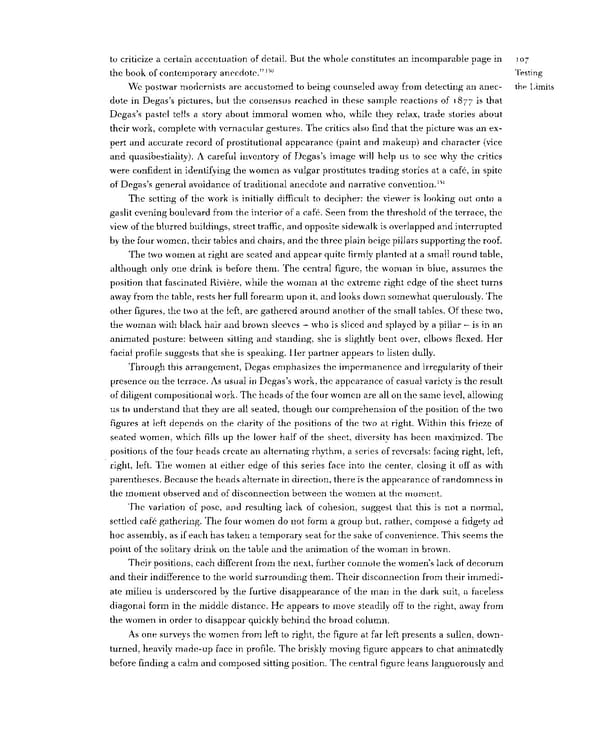to criticize a certain accentuation of detail. But the whole constitutes an incomparable page in 107 the book of contemporary anecdote." 15° Testing We postwar modernists are accustomed to being counseled away from detecting an anec- the Limits dote in Degas's pictures, but the consensus reached in these sample reactions of 1877 is that Degas's pastel tells a story about immoral women who, while they relax, trade stories about their work, complete with vernacular gestures. The critics also find that the picture was an ex- pert and accurate record of prostitutional appearance (paint and makeup) and character (vice and quasibestiality). A careful inventory of Degas's image will help us to see why the critics were confident in identifying the women as vulgar prostitutes trading stories at a cafe, in spite 151 of Degas's general avoidance of traditional anecdote and narrative convention. The setting of the work is initially difficult to decipher: the viewer is looking out onto a gaslit evening boulevard from the interior of a cafe. Seen from the threshold of the terrace, the view of the blurred buildings, street traffic, and opposite sidewalk is overlapped and interrupted by the four women, their tables and chairs, and the three plain beige pillars supporting the roof. The two women at right are seated and appear quite firmly planted at a small round table, although only one drink is before them. The central figure, the woman in blue, assumes the position that fascinated Riviere, while the woman at the extreme right edge of the sheet turns away from the table, rests her full forearm upon it, and looks down somewhat querulously. The other figures, the two at the left, are gathered around another of the small tables. Of these two, the woman with black hair and brown sleeves — who is sliced and splayed by a pillar — is in an animated posture: between sitting and standing, she is slightly bent over, elbows flexed. Her facial profile suggests that she is speaking. Her partner appears to listen dully. Through this arrangement, Degas emphasizes the impermanence and irregularity of their presence on the terrace. As usual in Degas's work, the appearance of casual variety is the result of diligent compositional work. The heads of the four women are all on the same level, allowing us to understand that they are all seated, though our comprehension of the position of the two figures at left depends on the clarity of the positions of the two at right. Within this frieze of seated women, which fills up the lower half of the sheet, diversity has been maximized. The positions of the four heads create an alternating rhythm, a series of reversals: facing right, left, right, left. The women at either edge of this series face into the center, closing it off as with parentheses. Because the heads alternate in direction, there is the appearance of randomness in the moment observed and of disconnection between the women at the moment. The variation of pose, and resulting lack of cohesion, suggest that this is not a normal, settled cafe gathering. The four women do not form a group but, rather, compose a fidgety ad hoc assembly, as if each has taken a temporary seat for the sake of convenience. This seems the point of the solitary drink on the table and the animation of the woman in brown. Their positions, each different from the next, further connote the women's lack of decorum and their indifference to the world surrounding them. Their disconnection from their immedi- ate milieu is underscored by the furtive disappearance of the man in the dark suit, a faceless diagonal form in the middle distance. He appears to move steadily off to the right, away from the women in order to disappear quickly behind the broad column. As one surveys the women from left to right, the figure at far left presents a sullen, down- turned, heavily made-up face in profile. The briskly moving figure appears to chat animatedly before finding a calm and composed sitting position. The central figure leans languorously and
 Prostitution & Impressionists Page 127 Page 129
Prostitution & Impressionists Page 127 Page 129